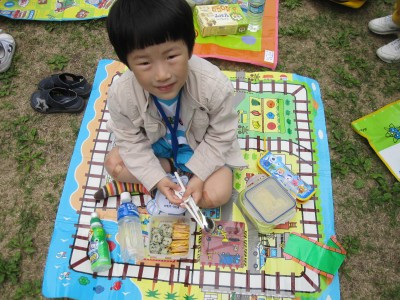
Eddie, chopsticks in hands, gets ready to chow down on some kimbap and spam patties on field trip day.
At the public elementary school, many students have a full 40-minute class period for lunch, sometimes even an hour. Each day they eat rice and kimchi and drink water or white milk. There is often but not always a meat or fish, another vegetable side dish (though it’s rare to eat fresh vegetables here), and sometimes fruit. Occasionally, depending on the school, they get chocolate milk. Today, my third grader told me he ate noodles with black bean sauce, a popular Chinese dish. My middle schoolers say their lunch now is better than before, and for late afternoon study halls they’re served small dinners of noodles and other food. Wednesdays are traditionally “special” lunch days, with rice replaced by another main course.
A recent article and blog about rising child obesity in Korea, cited late-night academies, over-packed schedules, and the prevalence of convenience stores (sodium-heavy ramen, cookies, etc) and greasy street food as culprits. I agree entirely, and point out that in the long run these sacrificial schedules I the name of educational emphasis will backfire if the unhealthy irregular diets start affecting energy and development.
在郊游时,埃迪正拿着筷子准备吃韩式寿司和午餐肉。
在公立小学,很多学生有整整40分钟时间来吃午饭,有时甚至达到一个小时。每一天,他们都吃米饭和泡菜,喝水或者牛奶。他们经常能但并不总是能吃到肉或鱼,蔬菜配菜(虽然在这里很难吃到新鲜蔬菜),有时是水果。学校偶尔会为他们提供巧克力牛奶。今天,我的一个三年级学生告诉我,他吃了豉酱面条,那是一种知名的中国菜。我的一个初中学生说,他们的午餐现在是比以前好些了,傍晚的时候,他们可以在学习室吃到面条等食品作为小晚餐。周三在传统上是“特殊”午餐日,米饭会更换为另一种主食。
最近一些关于韩国儿童肥胖上升的文章和博客,指出夜校,过度利用的时间表,以及便利店的普遍(富含钠的面条,饼干等)和油腻的街头食品是罪魁祸首。我完全同意,同时想指出,从长远来看,如果不健康不规律的饮食开始影响能源和发展,这些被我成为强调教育的而牺牲的时间的恶果将显现出来。














